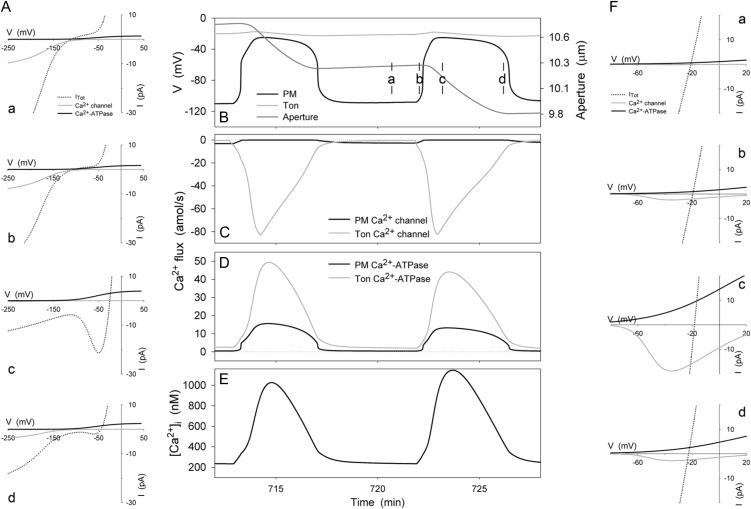Figure 8.
[Ca2+]i and analysis of the Ca2+ flux across the plasma membrane and tonoplast during voltage and [Ca2+]i excursions at the end of the daylight period. Shown are the plasma membrane and tonoplast voltages, and the stomatal aperture (B), the Ca2+ influx through the Ca2+ channels at the plasma membrane and tonoplast (C), the Ca2+ efflux through the plasma membrane and tonplast Ca2+ ATPases (D), and the [Ca2+]i (E). Current-voltage curves for these Ca2+ transporters at the plasma membrane and tonoplast are shown in E and F, respectively. Total membrane current is indicated in each case by the dotted line; the free-running membrane voltage is defined by the point at which this line crosses the voltage axis. Current-voltage curves are cross-referenced to time points in B to E by letter. As in Figure 7, time point a is characterized by plasma membrane hyperpolarization, which favors Ca2+ influx through the Ca2+ channels at the plasma membrane; time point c is characterized by plasma membrane depolarization, which favors Ca2+ efflux through the plasma membrane Ca2+-ATPase. Note the Ca2+ influx at the plasma membrane is replaced by Ca2+ influx across the tonoplast shortly before plasma membrane depolarization (C); thereafter, the characteristics of the [Ca2+]i rise are determined by Ca2+ flux from the tonoplast and, as the tonoplast Ca2+ channels inactivate, by [Ca2+]i recovery-mediated Ca2+-ATPases at the two membranes (D). Note that positive flux is defined as movement of the ionic species (not the charge) out of the cytosol, either across the plasma membrane or the tonoplast.

